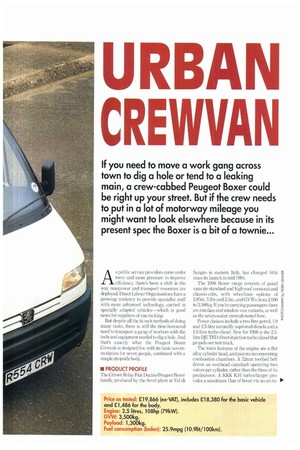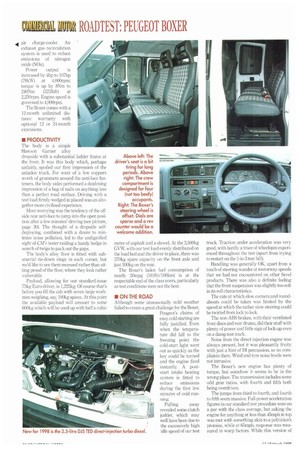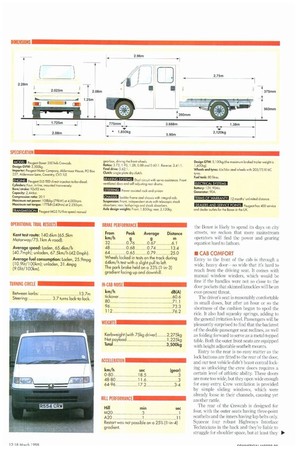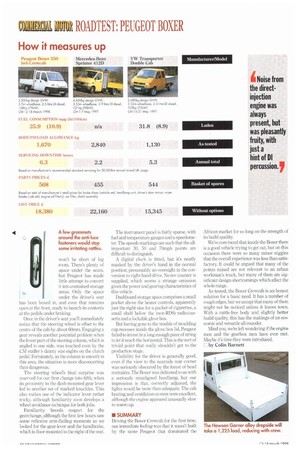URBAN CR ittIVAN
Page 29

Page 30

Page 31

Page 32

If you've noticed an error in this article please click here to report it so we can fix it.
If you need to move a work gang across town to dig a hole or tend to a leaking main, a crew-cabbed Peugeot Boxer could be right up your street. But if the crew needs to put in a lot of motorway mileage you might want to look elsewhere because in its present spec the Boxer is a bit of a townie...
As public service providers come under more and more pressure to improve efficiency, there's been a shift in the way manpower and transport resources are deployed. Direct Labour Organisations have a growing tendency to provide specialist staff with more advanced technology, carried in specially adapted vehicles—which is good news for suppliers of van racking.
But despite all the hi-tech methods of doing many tasks, there is still the time-honoured need to transport a gang of workers with the tools and equipment needed to dig a hole. And that's exactly what the Peugeot Boxer Crewcab is designed for, with its basic accommodation for seven people, combined with a simple dropside body.
• PRODUCT PROFILE The Citroen Relay/Fiat Ducato/Peugeot Boxer family, produced by the Sevel plant at Val di Sangro in eastern Italy, has changed little since its launch in mid-1994.
The 1998 Boxer range consists of panel ul vans (in standard and high-roof versions) and chassis-cabs, with wheelbase options of 12.85m, 3.2m and 3.5m, and GVWs from 2,000 to 3,500kg. If you're carrying passengers there are minibus and window-van variants, as well as the seen-seater crewaib tested here.
Power choices include a two-litre petrol, 1.9 and 2.5-litre naturally aspirated diesels and a 1.9-litre turbo-diesel. New for 1998 is the 2.5litre DJ5 TED direct-injection turbo-diesel that propels our test truck.
The main features of the engine are a flat alloy cylinder head, and pistons incorporating combustion chambers. A 32mm toothed belt drives an overhead camshaft operating two valves per cylinder, rather than the three of its predecessor. A KKK K16 turbocharger provides a maximum lbar of boost via an air-to■ air charge-cooler. An exhaust gas recirculation system is used to reduce emissions of nitrogen oxide (N0x).
Power output is increased by 4hp to 107hp (79kW) at 4,000rpm; torque is up by 8Nm to 240Nm (325Ibft) at 2,250rpm. Engine speed is governed to 4,900rpm.
The Boxer comes with a 12-month unlimited distance warranty with optional 12 or 24-month extensions.
• PRODUCTIVITY The body is a simple Hawson Garner alloy clropside with a substantial ladder frame at the front. It was this body which, perhaps unfairly, spoiled our first impression of the unladen truck, For want of a few coppers worth of grommets around the anti-luce fasteners, the body sides performed a deafening impression of a bag of nails on anything less than a perfect road surface. Driving with a test load firmly wedged in placed was an altogether more civilised experience.
More worrying was the tendency of the offside rear anti-luce to jump into the open position after a few minutes' driving (see picture, page 30). The thought of a dropside selfdeploying, combined with a desire to minimise noise pollution, led to the undignified sight of CM's tester raiding a handy hedge in search of twigs to pack out the gaps.
The body's alloy floor is fitted with substantial tie-down rings in each corner, but we'd like to see them recessed rather than sitting proud of the floor, where they look rather vulnerable.
Payload, allowing for our standard-issue 75kg Euro-driver, is 1,225kg. Of course that's before you fill the cab with seven large workmen weighing, say, 100kg apiece. At this point the available payload will amount to some 600kg which will be used up with half a cubic
metre of asphalt and a shovel. At the 3,500kg GVW, with our test load evenly distributed OD the load bed and the driver in place, there was 370kg spare capacity on the front axle and just 100kg on the rear.
The Boxer's laden fuel consumption of nearly 26mpg (10.9lit/100km) is at the respectable end of the class norm, particularly as test conditions were not the best.
• ON THE ROAD Although some unseasonally mild weather failed to create a great challenge for the Boxer, Peugeot's claims of easy cold starting are fully justified. Even when the temperature did fall to the freezing point the cold-start light went out as quickly as the key could be turned and the engine fired instantly. A poststart intake heating system is fitted to reduce emissions during the first few minutes of cold running.
Pulling away revealed some clutch judder, which may well have been due to the excessively high idle speed of our test truck. Traction under acceleration was very good, with hardly a trace of wheelspin experienced throughout the test (apart from trying to restart on the 1-in-3 test hill).
Handling was generally OK, apart from a touch of steering wander at motorway speeds that we had not encountered on other Sevel products. There was also a definite feeling that the front suspension was slightly too soft in its roll characteristics.
The rate at which slow corners and roundabouts could be taken was limited by the speed at which the rather slow steering could be twirled from lock to lock.
The non-ABS brakes, with their ventilated front discs and rear drums, did their stuff with plenty of power and little sign of lock-up even on a damp test track.
Noise from the direct-injection engine was always present, but it was pleasantly fruity with just a hint of DI percussion, so no complaints there. Wind and tyre noise levels were not intrusive.
The Boxer's new engine has plenty of torque, but somehow it seems to be in the wrong place. The transmission includes some odd gear ratios, with fourth and fifth both being overdriven.
The jumps from third to fourth, and fourth to fifth seem massive. Full-power acceleration figures in our standard test procedure were on a par with the class average, but asking the engine for anything at less than 45mph in top was met with something akin to a politician's promise, while at 65mph, response was measured in warp factors. While this version of the Boxer is likely to spend its days on city streets, we reckon that more mainstream operators will find the power and gearing equation hard to fathom.
• CAB COMFORT
Entry to the front of the cab is through a wide, heavy door—so wide that it's hard to reach from the driving seat. It comes with manual window winders, which would be fine if the handles were not so close to the door pockets that skinned knuckles will be an ever-present threat.
The driver's seat is reasonably comfortable in small doses, but after an hour or so the shortness of the cushion began to spoil the ride. It also had squeaky springs, adding to the genend irritation level. Passengers will be pleasantly surprised to find that the backrest of the double passenger seat reclines, as well as folding forward to serve as a metal-topped table. Both the outer front seats are equipped with height adjustable seatbelt mounts.
Entry to the rear is no easy matter as the lock buttons are fitted to the rear of the door, and our test vehicle didn't boast central locking so unlocking the crew doors requires a certain level of athletic ability. These doors are none too wide, but they open wide enough for easy entry. Crew ventilation is provided by simple sliding windows, which were already loose in their channels, causing yet another rattle.
The rear of the Crewcab is designed for four, with the outer seats having three-point seatbelts and the inners having lap belts only. Squeeze four robust Highways Interface Technicians in the back and they're liable to struggle for shoulder space, but at least they 111. won't be short of leg room. There's plenty of space under the seats, but Peugeot has made little attempt to convert it into contained storage areas. Only the space under the driver's seat has been boxed in, and even that remains open at the front, ready to launch its contents at the pedals under braking.
Once in the driver's seat you'll immediately notice that the steering wheel is offset to the centre of the cab by about 60mm. Engaging a gear reveals another potential problem when the lower part of the steering column, which is angled to one side, was touched even by the CM staffer 's dainty size eights on the clutch pedal. Fortunately, as the column is smooth in this area, the situation is more disconcerting than dangerous.
The steering wheel's final surprise was reserved for our first change into fifth, when its proximity to the dash-mounted gear lever led to another set of marked knuckles. This also makes use of the indicator lever rather tricky, although familiarity soon develops a wheel-avoidance technique for both jobs.
Familiarity breeds respect for the gearchange, although the first few hours saw some reflexive arm-flailing moments as we looked for the gear-lever and the handbrake, which is floor-mounted to the right of the seat. The instrument panel is fairly sparse, with fuel and temperature gauges and a speedometer. The speedo markings are such that the allimportant 30, 50 and 70mph points are difficult to distinguish.
A digital clock is fitted, but it's neatly masked by the driver's hand in the normal position; presumably an oversight in the conversion to right-hand-drive. No rev counter is supplied, which seems a strange omission given the power and gearing characteristics of this vehicle.
Dashboard storage space comprises a small pocket above the heater controls, apparently just the right size for a packet of cigarettes, a small shelf below the (non-RDS) radio/cassette and a lockable glove box.
But having gone to the trouble of moulding cup recesses inside the glove box lid, Peugeot failed to invest in a long enough piece of string to let it reach the horizontal. This is the sort of trivial point that really shouldn't get to the production stage.
Visibility for the driver is generally good, even if the view to the nearside rear corner was seriously obscured by the forest of head restraints. The Boxer was delivered to us with a seriously misaligned headlamp, but our impression is that, correctly adjusted, the lights would be more than adequate. The cab heating and ventilation system were excellent, although the engine appeared unusually slow to warm-up.
• SUMMARY
Driving the Boxer Crewcab for the first time, our immediate feeling was that it wasn't built by the same Peugeot that dominated the African market fur so long on the strength of its build quality.
We're convinced that inside the Boxer there is a good vehicle trying to get out, but on this occasion there were so many minor niggles that the overall experience was less than satisfactory. It could be argued that many of the points raised are not relevant to an urban workman's truck, but many of them are significant design shortcomings which affect the whole range.
As tested, the Boxer Crewcab is an honest solution for a basic need. It has a number of rough edges, but we accept that many of them might not be noticed unless it leaves town. With a rattle-free body and slightly better build quality, this has the makings of an economic and versatile all-rounder.
Mind you, we're left wondering if the engine men and the gearbox men have ever met. Maybe it's time they were introduced.
E by Colin Barnett Price as tested. £19,866 (ex-VAT), includes £18,380 for the basic vehicle and £1,486 for the body.
Engine: 2.5 litres, 108hp (79kW).
GVW: 3,500kg. Payload. 1,300kg. Fuel consumption (laden): 25.9mpg (10.91it/100km).
SPECIFICATION
nDEL Peugeot Boxer 350 twb Crewcab. Design GVW: 3,500kg.
Importer: Peugeot Motor Company, Aldermoor House, PO Box 227, Aldermoor Lane, Coventry, CV3 1LT IMIE Peugeot D.I5 TED direct-injection turbo-diesel. Cylinders: Four, in-line, mounted transversely.
Bore/stroke: 92x92 mm.
Capacity: 2,446cc.
Compression ratio: 20:1 Maximum net power.: 1086hp I79kW) at 4,000rpm. Maximum net torque: 1771bit (24014ml at 2.250rpm.
TRATTSmIS;,0E. Peugeot M05 TU five-speed manual
gearbox, driving the front wheels.
Ratios: 3.73,1.95, .28,0.88 and 0.60:1. Reverse: 3.41:1. Final drive: 5.62:1.
CluSch: single-plate dry dutch.
ST AKING svs Dual-circuit with servo assistance. Front
ventilated discs and self-adjusting rear drums.
Power assisted rack-and-pinion OM Ladder frame steel chassis with integral cob. Suspension: Front, independent struts with telescopic shock absorbers; rear, leafsprings and shock absorbers. Axle design weights: Front, 1,850kg; rear, 2,120kg. Design GTW: 5,1 00kg the maximum braked trailer weight is ,600Itg) Wheels and tyres: 6Jtc 1 ain steel wheels with 205/75 RI 6C tyres.
Fuel tank: 80 litres ELECTRICAL SYSTEMS
Battery: I 2V, 90Ari. Generator: 91:IA.
TERMS OF WARRANTY 12 months unlimited distance.
DEALERS AND SERVICE POINTS Peugeot has 400 service and dealer o• . • Boxer in the UK.
OPERATIONAL TRIAL RESULTS Kent test route: 140.6km (65.5km Motorway/75.1km A-road).
Average speed: Laden, 65.4km/h (40.7mph); unladen, 67.5km/h (42.0mph).
Average fuel consumption: Laden, 25.9mpg (10.91it/100km); unladen, 31.4mpg (9.01it/100km).
TURNING CIRCLE
Between kerbs: 13.7m
Steering: 3.7 turns lock-to-lock. IN-CAB NOISE km/h dB(A) tickover 60.6 80 71.1 96 73.3 112 76.2 WEIGHTS Kerbweight (with 75kg driver) 2,275kg Net payload 1,225kg
Total 3,500kg
ACCELERATION
km/h sec (gear)
0-80 18.5 3 48-80 11.6 3 64-96 17.2 3-4 HILL PERFORMANCE
Hill min sec
M20 3 1 A20 1 11 Restart was not possible on a 25% (1-in-4) gradient.








































































































